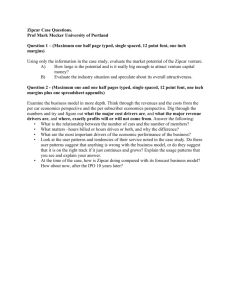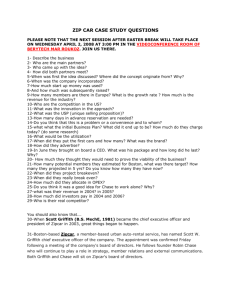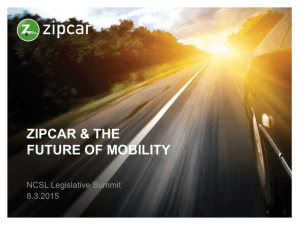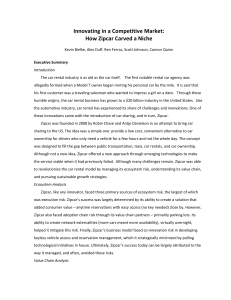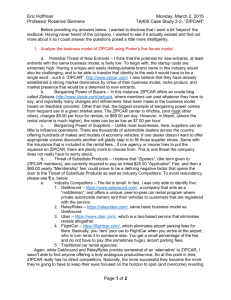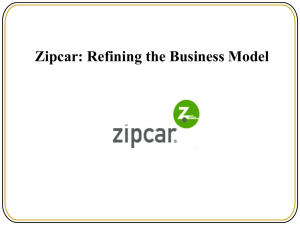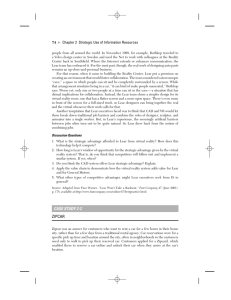zipcar in the headlights
advertisement
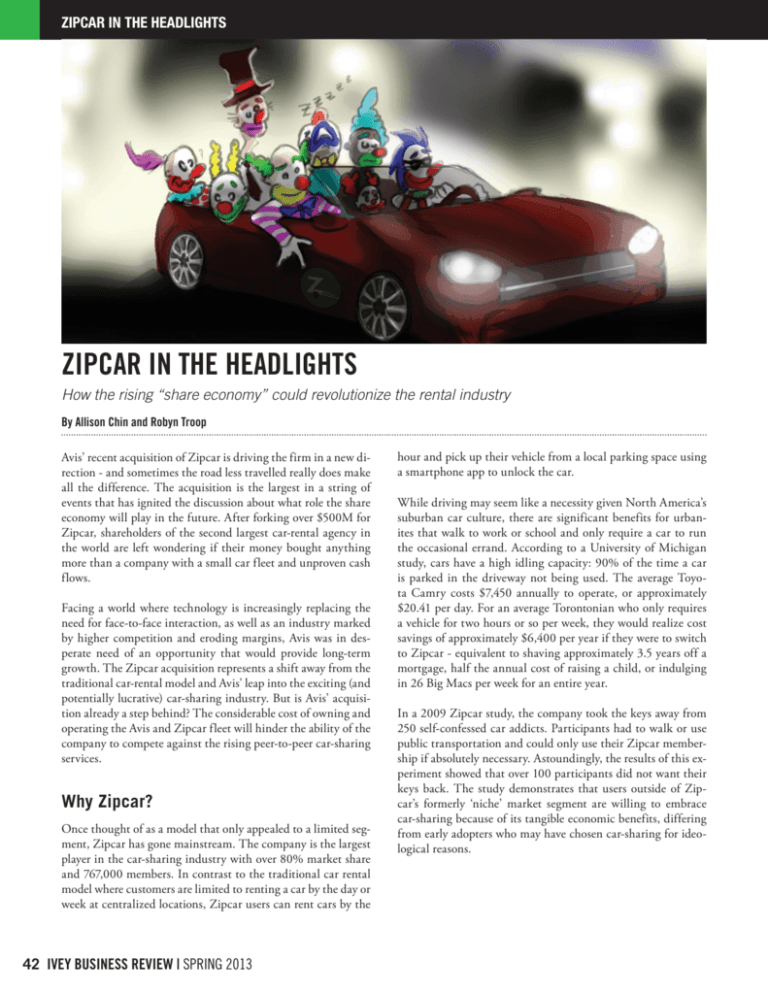
ZIPCAR IN THE HEADLIGHTS ZIPCAR IN THE HEADLIGHTS How the rising “share economy” could revolutionize the rental industry By Allison Chin and Robyn Troop Avis’ recent acquisition of Zipcar is driving the firm in a new direction - and sometimes the road less travelled really does make all the difference. The acquisition is the largest in a string of events that has ignited the discussion about what role the share economy will play in the future. After forking over $500M for Zipcar, shareholders of the second largest car-rental agency in the world are left wondering if their money bought anything more than a company with a small car fleet and unproven cash flows. Facing a world where technology is increasingly replacing the need for face-to-face interaction, as well as an industry marked by higher competition and eroding margins, Avis was in desperate need of an opportunity that would provide long-term growth. The Zipcar acquisition represents a shift away from the traditional car-rental model and Avis’ leap into the exciting (and potentially lucrative) car-sharing industry. But is Avis’ acquisition already a step behind? The considerable cost of owning and operating the Avis and Zipcar fleet will hinder the ability of the company to compete against the rising peer-to-peer car-sharing services. Why Zipcar? Once thought of as a model that only appealed to a limited segment, Zipcar has gone mainstream. The company is the largest player in the car-sharing industry with over 80% market share and 767,000 members. In contrast to the traditional car rental model where customers are limited to renting a car by the day or week at centralized locations, Zipcar users can rent cars by the 42 IVEY BUSINESS REVIEW | SPRING 2013 hour and pick up their vehicle from a local parking space using a smartphone app to unlock the car. While driving may seem like a necessity given North America’s suburban car culture, there are significant benefits for urbanites that walk to work or school and only require a car to run the occasional errand. According to a University of Michigan study, cars have a high idling capacity: 90% of the time a car is parked in the driveway not being used. The average Toyota Camry costs $7,450 annually to operate, or approximately $20.41 per day. For an average Torontonian who only requires a vehicle for two hours or so per week, they would realize cost savings of approximately $6,400 per year if they were to switch to Zipcar - equivalent to shaving approximately 3.5 years off a mortgage, half the annual cost of raising a child, or indulging in 26 Big Macs per week for an entire year. In a 2009 Zipcar study, the company took the keys away from 250 self-confessed car addicts. Participants had to walk or use public transportation and could only use their Zipcar membership if absolutely necessary. Astoundingly, the results of this experiment showed that over 100 participants did not want their keys back. The study demonstrates that users outside of Zipcar’s formerly ‘niche’ market segment are willing to embrace car-sharing because of its tangible economic benefits, differing from early adopters who may have chosen car-sharing for ideological reasons. ZIPCAR IN THE HEADLIGHTS The Share Economy Zipcar is one of many businesses that operate in what has become known as the “share economy.” The share economy is propelled by online market platforms that allow consumers to demand goods and services in a way that most efficiently meets their needs on a cost basis. These online platforms have spurred growth in pay-per-use services. The share economy gives consumers the opportunity to rent specific goods and services directly from their peers, allowing for better capacity utilization and a lower net cost to the owner. As proponents of the share economy like to put it, “access trumps ownership.” Referred to as collective consumption, this growing consumer trend is expected to play an increasing role in global markets. A well-known example of the sharing phenomenon is Airbnb, an online platform connecting individuals looking for a cheap place to stay with homeowners willing to rent out their extra space. In this win-win-win scenario, travelers save on accommodations, homeowners benefit from extra rental income, and Airbnb earns a 3% fee on every transaction. Although margins are slim, profits are increasing as more people use Airbnb’s services: over 15 million guest nights were booked in 2012. Rapid growth in users and burgeoning interest in the share economy has led to Airbnb’s current valuation of over $2.5B. This practice is scalable across several industries. Companies such as Capital Bikeshare, Bixi, and SmartBike provide over 2.2 million bike-sharing trips each month. DogVacay provides home-sitting as an alternative to kennels. Fon shares WiFi access between its 7 million members. Lending Club provides members with short-term cash at low interest rates – the “share” financial lending market is expected to grow to $5B by the end of 2013. Recent figures on the share economy indicate that people are more willing to share and the number of users participating in this market is growing rapidly. Rachel Botsman, author of “What’s Mine is Yours: The Rise of Collaborative Consumption” and a frequent TED contributor, predicts that the total share economy is a $110B market, and car-sharing revenues will reach $3.3B by 2016. In 2010, Time Magazine named ‘collaborative consumption’ as one of the top 10 disruptive ideas that would change the world. The share economy has virtually no limits. What’s Mine is Yours A closer look at the P2P model For Renters: Search online for your perfect car Hit the road Meet the owner for the keys 1 2 34 Return the car to the owner. Say thanks! P For Owners: List your car online Meet the driver and get paid Choose the driver 1 2 34 Wait for the driver to return the car. Rate the driver! $ $ $$ $$ $$ $$ Avis purchased Zipcar to gain access to the share economy; however, the company’s business model may already be outdated in this rapidly evolving market. The car-sharing market has moved beyond Zipcar’s fleet model; new entrants now offer peer-to-peer (P2P) car-sharing services. Rather than owning and operating a fleet of cars, P2P companies like RelayRides, Zimride, Spride, and Getaround simply enable the sharing of vehicles owned by individuals. The largest of the P2P car-shar- The Car Sharing Process IVEY BUSINESS REVIEW | SPRING 2013 43 ZIPCAR IN THE HEADLIGHTS ing services, RelayRides, has vehicles available in over 1,300 U.S. cities across all 50 states. P2P car-sharing services not only offer consumers access to an online market, but also guarantee a level of comfort and security that could not be obtained through individual P2P transactions. P2P car-sharing companies complete vehicle and renter background checks, provide insurance, and, in the case of RelayRides, install devices in each car so that only members can start the car’s ignition. For these services, P2P car-sharing companies take an approximate 40% cut of the car rental fee. After this fee the owner of the vehicle can use the generated revenue to cover lease payments, maintenance costs, or other expenses, supplementing their personal income. “Currently, the P2P car-sharing industry is small, fragmented, and ripe for acquisition by a large player with strong brand recognition and an established organizational structure.” Even with Avis’ infrastructure and marketing support, Zipcar simply cannot compete on price with P2P car-sharing companies. With zero fleet, maintenance, or parking costs, P2P boasts a more favorable cost structure. P2P companies are able to pass on significant savings to their customers, reinvest additional resources into building scale, and improve customer service during initial growth phases. Furthermore, Zipcar’s user acquisition costs increased 27% as the company grew between 2011 and 2012. This indicates that customers are becoming more expensive to attract – an unwelcome sign for Avis. On the other hand, P2P car-sharing companies have a natural source of marketing from the people using the service to rent out their cars. P2P users are more incentivized to market the service through word of mouth since they are the ultimate beneficiaries of the P2P transaction. Avis in the Fast Lane After learning from Avis’ early move, there is now an opportunity for competitors such as Hertz or Enterprise to capitalize on the car-sharing industry. Although Zipcar is currently the market leader, an incumbent in the pure P2P space could potentially provide more value for members at a lower cost. Currently, the P2P car-sharing industry is small, fragmented, and ripe for acquisition by a large player with strong brand recognition and an established organizational structure. Traditional rental giants could take the lead by acquiring one of the larger P2P players, such as RelayRides or GetAround, and utilizing their internal capabilities to increase the scope of the acquired company. 44 IVEY BUSINESS REVIEW | SPRING 2013 Even with the movement towards P2P, Avis can maintain a dominant position in the industry if they adapt Zipcar’s strategy to compete with the lower prices offered by P2P firms. Within Zipcar’s existing business model, there is room to begin testing the market for an eventual transition towards a partly P2P model. Therefore, while it is important to focus on growing the current membership base and improving margins, Avis cannot afford to overlook the changes that are occurring in this evolving industry. Avis could steer Zipcar towards the P2P business model by introducing some of its used vehicles into the P2P market. Conventionally, Avis’ rental cars are driven for a fraction of the vehicle’s useful life and returned to the manufacturer. These vehicles are then re-sold at reduced prices. Under the P2P model, Avis could sell their outdated fleet directly to individuals at a discounted price, under the condition that new owners allow the cars to become a part of Zipcar’s P2P network for a pre-determined time frame. Cars would be equipped with Zipcar’s remote scheduling and unlocking system while being available in public spaces at times convenient for the car owner and other Zipcar members. For example, a car owner who only needs their vehicle for the work week commute may agree to have their car accessible during evenings and weekends for rental. In addition to a lower purchase price, the car owner would receive a percentage of revenue each time their car is rented. Simultaneously, Avis/Zipcar can maintain control over their fleet’s age and quality, make more efficient use of their assets, and decrease fleet costs. This method could place Zipcar at an advantage over its P2P competitors who face potential difficultly and high acquisition costs in finding willing members to rent out their cars. While Hertz and Enterprise could attempt to replicate this strategy, creating a P2P company from scratch takes time and a new firm would not have the same brand recognition as Zipcar. If car owners were required to make their cars available to these P2P services, owners would want to make their purchase from the company with the largest user base in order to maximize their potential rental revenue. Furthermore, with a commitment to the Zipcar brand, after-purchase users will be forced to remain loyal to Zipcar in an industry characterized by low switching costs. To be competitive with Avis and Zipcar, Hertz or Enterprise would first have to create a substantial user base through acquisitions. Given that Avis has already entered the car-sharing market, they now have the opportunity to build scale before large competitors enter. Avis has a head start in this race; if they position themselves to suit the needs of the rapidly evolving share economy, they can speed towards the finish line and leave their competitors in the dust.
